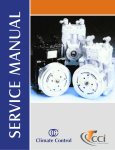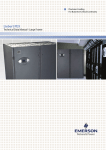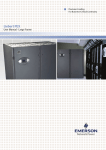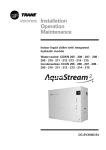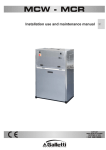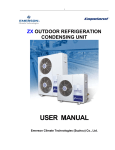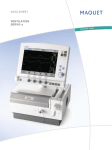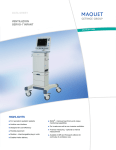Download Service Manual
Transcript
Service Manual SECTION 2 • Service - Clutch Servicing (Removal & Installation) - Shaft Seal Servicing (Removal & Installation) - Head & Valve Plate Servicing (Removal & Installation) - Baseplate Servicing (Removal & Installation) - Gasket Treatment - Noise Complaints - Seal Tool Kit Components LAST REVISION 08/98 SUPERSEDES FORMS: 180.72-NM • 180.72-NM2 • 180.72-RP • YA77-401 ® Climate Control Inc. A DEMIRCO COMPANY Service The majority of compressor parts are made up of aluminum alloys and care must be taken in handling not to mar, nick or scratch. All machined surfaces must be free of nicks and burrs to insure proper fit and gasket seating. When replacing parts and securing with bolts or cap screws, the specified torque requirements on page 15 should never be exceeded. Bolts should all be run in until the bolt heads make contact, then tightened with a torque wrench in a sequence resulting in tightening of diagonally opposite bolts until all are drawn up to specified torques. (Refer to torque sequence page 15.) An important factor in compressor servicing is cleanliness and care should be exercised to prevent dirt or foreign material from entering the compressor when it is opened. All old gaskets should be removed and replaced. All gasket surfaces should be clean and all parts to be reused should be washed in a suitable petroleum base solvent. 2. Install clutch removal bolt into the clutch. Using the adjustable spanner wrench to hold the clutch pulley in place, tighten the clutch bolt until the clutch pulley is forced free. CLUTCH SERVICING REMOVAL 3. Remove the clutch mounting bolts. INSTALLATION 1. Check that a key is properly inserted in the shaft of the compressor. 1. Remove the clutch center bolt and washer using the adjustable spanner wrench to hold the clutch pulley. Climate Control Inc. 3. Place clutch pulley over shaft making sure to align the key way over the shaft key. 4. Install and tighten the clutch center bolt and washer using a torque wrench to 20-25 ft. lbs. (27.1-33.9 Nm). 5. Spin the clutch pulley to verify there is no interference. Verify the clutch engages when the proper voltage is applied. 2. Mount and center the coil bracket. Tighten the four clutch mounting bolts using a torque wrench to 13-19 ft. lbs. (17.6-25.8 N-m). NOTE: Only use bolts that have a loctite patch on the threads. Service Manual SHAFT SEAL SERVICING REMOVAL The shaft seal assembly of the CCI compressor is of a simplified design, yet tight sealing, long lasting and, when necessary, easily and quickly replaced. CCI seals are machined to 3 helium light bands of flatness. The carbon is lapped to the seal plate and the fit becomes even better as the seal assembly is “run in” during operation. 1. Remove the compressor and place on work bench. The tendency to condemn a seal assembly because of very slight leakage is an error that is often committed. Few if any mechanical seal assemblies are 100% tight. The rubbing surfaces of the seal are separated by a very fine film of oil. Oil carries refrigerant and minute quantities which seep to the outside may be detected with ultra sensitive leak detectors which are capable of sensing leakage totalling one ounce of refrigerant over a twenty year period. Such sensitivity serves a useful purpose in critical applications but for leak testing compressor joints or seal, a leak detector will pick up any leak of sufficient magnitude to require correction. Refer to comments on leak detector equipment, page 8. 5. Caution! Prior to removing the seal plate screws, be certain that any compressor internal pressure has been relieved! 2. Brush off debris and dirt. 3. Use a clean lint free shop cloth to wipe clean the exposed end of the crankshaft. Do not be too prone to condemn and replace a seal assembly until the seal has been given an opportunity to “run in” and until there is definite proof that replacement is really necessary. If a refrigerant leak from the area behind the compressor clutch is verified with a refrigerant leak detector, replacement of the compressor shaft seal is recommended. Note: Up to a few drops of compressor oil may normally be found in the area under the front seal. Do not replace a seal based on the presence of small amounts of oil. Verify a leak with a refrigerant leak detector before replacement, then proceed as follows: Climate Control Inc. Remove the screws that hold the seal plate in place and lift plate from the compressor. 6. Using a flat blade screw driver, or similar tool, pry up and remove the seal retainer assembly. Use care not to scratch or mar the crankshaft or the machined face of the compressor. 4. Use Climate Control Seal Kit 488-25274 7. In nearly every case the friction ring (boot) will not come off with the seal retainer assembly. Service Manual 2. Apply clean refrigerant oil to the seal plate “O” ring and place the ring into the seal plate “O” ring groove. Invert the plate and observe that the “O” ring remains in place. 8. With the tool used to remove the seal retainer assembly, carefully pry up and remove the friction ring (boot). Again, use care not to scratch or mar the crankshaft or machined face of the compressor. INSTALLATION 1. Use a clean, lint free shop cloth to wipe the crankshaft clean. Note: At this time the front main bearing is exposed, therefore care must be taken to prevent dirt or any type of contamination from falling into it. Climate Control Inc. 5. Prior to installation, check the seal assembly to make sure that the carbon seal ring is right side up (narrow polished band up), and confirm that the carbon rings notches are aligned with the drive tabs in the metal seal retainer. Lightly place the seal assembly (carbon ring side up) onto the oiled crankshaft. 3. Place a few drops of clean refrigerant oil on the face of the seal plate between the "O" ring and the inside diameter and with a clean finger spread the oil into a thin film. It is important that the surface not be over oiled and that there is no oil between the "O" ring groove and the outside diameter of the seal plate. 4. Apply clean refrigerant oil around the entire exposed end of the crankshaft. With a clean finger, uniformly spread the oil completely over the surface. Again, take care that no dirt or contamination falls onto he main bearing. 6. Insert the alignment tool into the seal plate and lightly place the plate’s polished face into contact with the seal assembly. With a uniform downward motion, use the alignment tool to push the seal plate into contact with Service Manual REMOVAL the crankcase face. Continue to hold pressure between the seal plate and the crankcase face while aligning and installing the six (6) hold down screws. Use a nut driver or similar tool for initial tightening. Failure to hold the seal plate against the crankcase face until all screws are firm against the seal plate may result in a chipped or broken carbon ring. Remove the centering tool and use a star pattern sequence to tighten the six (6) screws to a finish torque of 5-8 ft. lb. (7-11 N-m). 7. Install the metal dust cover, tapping it firmly into place. 8. Install felt ring dust shield, placing it around the seal plate and tight against the compressor housing. 9. Reinstall the clutch, using the four new screws supplied with the seal kit to attach the field coil assembly, tighten these screws to 13-19 ft.lb. (18-26 N-m). Install the clutch armature/pulley assembly and tighten the center bolt to 20-25 ft.lb. (27-34 N-m) Insure that the pulley spins freely. Remove the caps from the suction and discharge ports, and using the tool that tightened the center bolt, rotate the compressor six (6) to ten (10) revolutions to seat the carbon ring uniformly against the seal plate. Replace the suction and discharge port caps. HEAD AND VALVE PLATE SERVICING Prior to servicing the head and valve plate, both service valves should be opened to free any gas pressure which may be in the compressor. The cylinder head is made of aluminum and care should be taken when removing it not to damage the sealing surfaces. Climate Control Inc. 1. Remove the screws from flanged type service valves. Note that these four screws are longer than the remaining head screws. If the valves are of the Rotalock type or Tube 'O' type, remove by loosening the hex nuts which are a part of the valve assembly. 2. Remove the remaining screws in the head and remove the valve plate and head from the cylinder by prying or tapping under the ears which extend from the valve plate. If the head and valve plate adhere, hold the head and tap the valve plate ears away from the head with a soft hammer. Do not hit or tap the head to separate the head and valve plate because damage to the head may result. Service Manual BASEPLATE SERVICING 3. All gasket material adhering to the head, valve plate, or crankcase; should be carefully removed in such a manner that the machined sealing surfaces are not scratched or nicked. REMOVAL INSTALLATION Valves and valve plates are furnished only as a complete assembly. 1. Apply a thin film of clean refrigeration oil on the area of the crankcase to be covered by the crankcase gasket. Place the cylinder gasket in position on the cylinder so the dowel pins in the crankcase go through the dowel pin holes in the cylinder gasket. 2. Apply a thin film of clean refrigeration oil to the top and bottom valve plate areas to be covered by gaskets. Place the valve plate in position on the cylinder gasket so the discharge valve assemblies (i.e. the smaller diameter assemblies with the restrainer over the valve reed) are facing up and the locating dowel pins go through the dowel pin holes in the valve plate. 5. For a flange head, apply a thin film of clean refrigeration oil to the service valve flanges. Place an oiled service valve O-ring or gasket in position on the cylinder head service valve flanges. Place the service valves in position on the proper service valve ports (suction or discharge) and insert the four longer screws through the service valve mounting pads, the head, the valve plate, and into the crankcase. For a Tube 'O' or Rotalock head, insert the longer torx screws on the inside of the service valve ports and the shorter torx screws on the outside. Insert the remaining head screws and run in all the screws until the heads make contact. Tighten the head and service valve screws (using a torque wrench) to 17-25 ft. lbs. (23.0-33.9 N-m) in sequence as shown on torque sequence chart, page 15. 1. Remove the baseplate bolts. 2. Remove baseplate and gasket. If the baseplate is stuck, lightly tap the edges of the baseplate with a soft hammer. 3. Remove any gasket material adhering to the baseplate or crankcase. This should be done in a manner such that the sealing surfaces are not scratched or nicked. INSTALLATION 1. Apply a thin film of refrigeration oil to a new gasket and the sealing surface of the crankcase and baseplate. 3. Place the head gasket, with the bead facing up, in position on the valve plate so the dowel pins go through the dowel pin holes in the gasket. 4. Apply a light film of clean refrigeration oil on the machined surface of the cylinder head which matches the head gasket. Place the head on the cylinder head gasket so the dowel pins go into the dowel pin holes in the head. Climate Control Inc. 2. Properly align the gasket on the crankcase. Service Manual NOTES ON NOISE COMPLAINTS Many of the noise complaints can be traced to mount and drive and other related component problems. Normally if the unit is noisy at one speed and this noise clears up at another, it is not usually due to the compressor. Each vehicle has its critical frequencies where all vibrations get into the correct harmony to generate sound or noise. The speed at which these critical points are found will vary with each vehicle and each mount and drive arrangement. By changing the mount and drive components the noise level may be reduced. Many times the noise generated can be eliminated or greatly reduced by changing the belt adjustment to a different tension. A tension of 100 -120 lbs. (45-54 kg) is considered normal. 3. Install the baseplate and bolts. Tighten baseplate bolts to 10-16 ft. lbs. (13.6-21.7 N-m) in sequence given on page 15 using a torque wrench. GASKET TREATMENT Before assembly to the compressor, all gaskets should be dipped in clean refrigeration oil of the type used in the crankcase. Noises emanating from the clutch are difficult to recognize because of the close connecting feature with the compressor. A loose bolt holding the clutch to the shaft will result in extremely noisy operation. Extreme care must be exercised to prevent the removal of the wrong component. Since a compressor has many moving parts, it is normal for it to generate some noise just as a motor generates some noise as it is operated. The refrigerant gases, as they are moved by the compressor pistons, also produce noises and vibrations as a normal situation. Gaskets are made of a neoprene composition fiber and wicking action will result as oil follows the fiber. Do not mistake this wicking action for leaking. Wicking is a normal condition and is to be expected. CLASSIC # 22-1272 CCI (YORK) ESSENTIAL SEAL TOOL KIT 1 2 3 4 5 6 99-431 99-474 99-499 99-440 - CCI and Tecumseh Oil Level Checker Seal Installer and Plate Alignment Tool Universal Clutch Holder Wrench Clutch Remover 5/8 x 11 Thread (CCI and Tecumseh) 99-441 - Clutch Remover 5/8 x 18 Thread (CCI and Tecumseh) 99-473 - Universal Seal Remover BASIC COMPRESSOR TOOLS AVAILABLE THROUGH: CLASSIC TOOL DESIGN, INC. 31 WALNUT STREET • NEW WINDSOR, NY 12553 PH. 914-562-8700 • FAX 914-562-8596 Climate Control Inc. Service Manual ® Climate Control Inc. A DEMIRCOTM Company 2120 N. 22nd Street Decatur, Illinois 62526 Telephone: 217-422-0055 FAX: 217-422-4323 www.ccicompressor.com Information contained in this publication was in effect at the time the publication was approved for printing and is subject to change without notice or liability. Climate Control Inc. reserves the right to revise the information presented at any time. © Copyright 1999 Climate Control Inc. All rights reserved









